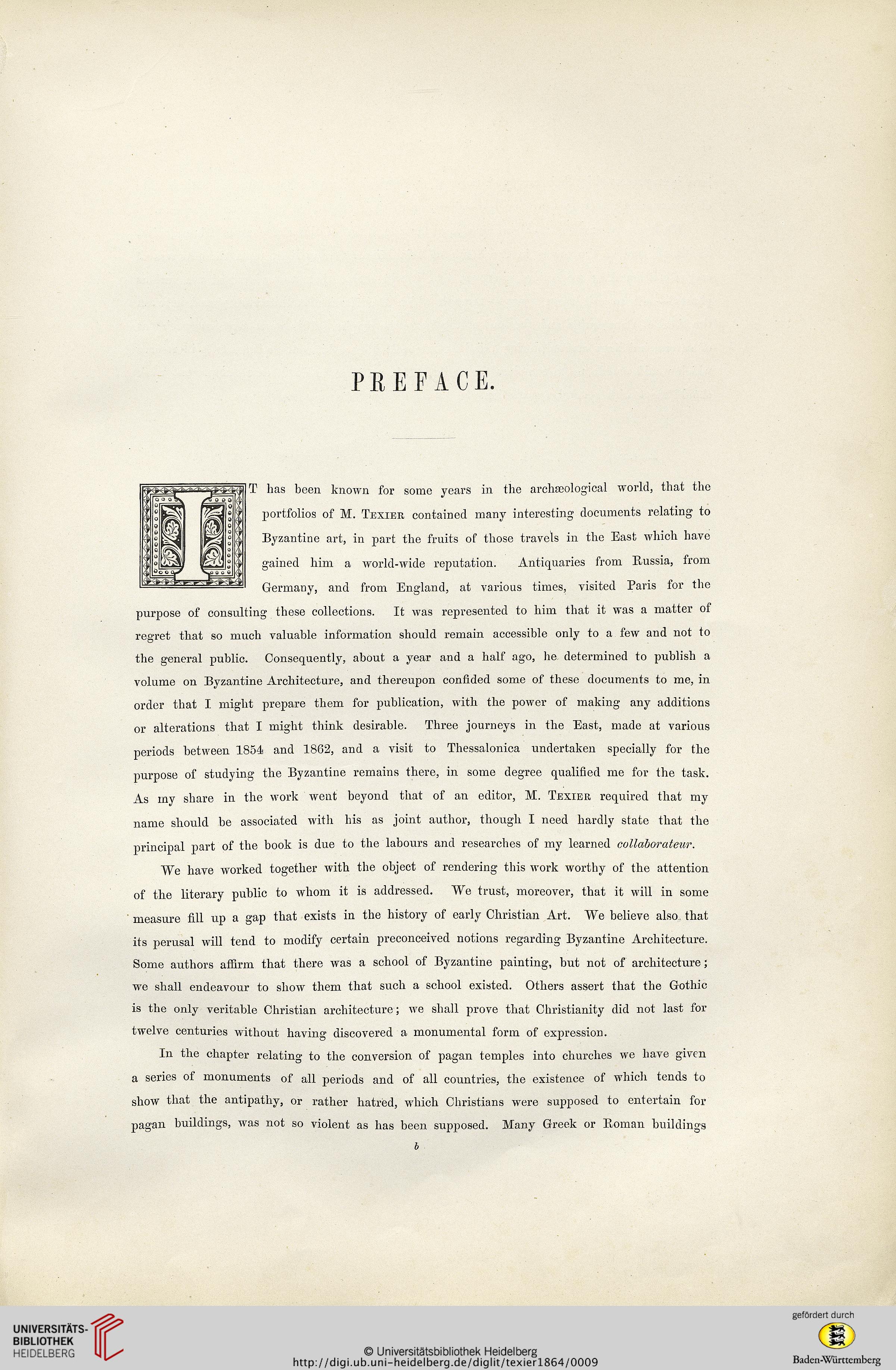PREFACE.
T has been known for some years in the archaeological world, that the
portfolios of M. Texier contained many interesting documents relating to
Byzantine art, in part the fruits of those travels in the East which have
gained him a world-wide reputation. Antiquaries from Russia, from
Germany, and from England, at various times, visited Paris for the
purpose of consulting those collections. It was represented to him that it was a matter of
regret that so much valuable information should remain accessible only to a few and not to
the general public. Consequently, about a year and a half ago, he determined to publish a
volume on Byzantine Architecture, and thereupon confided some of these documents to me, in
order that I might prepare them for publication, with the power of making any additions
or alterations that I might think desirable. Three journeys in the East, made at various
periods between 1854 and 1862, and a visit to Thessalonica undertaken specially for the
purpose of studying the Byzantine remains there, in some degree qualified me for fhe task.
As my share in the work went beyond that of an editor, M. Texier required that my
name should be associated with his as joint author, though I need hardly state that the
principal part of the book is due to the labours and researches of my learned collaborates.
We have worked together with the object of rendering this work worthy of the attention
of the literary public to whom it is addressed. We trust, moreover, that it will in some
measure fill up a gap that exists in the history of early Christian Art. We believe also that
its perusal will tend to modify certain preconceived notions regarding Byzantine Architecture.
Some authors affirm that there was a school of Byzantine painting, but not of architecture;
we shall endeavour to show them that such a school existed. Others assert that the Gothic
is the only veritable Christian architecture ; we shall prove that Christianity did not last for
twelve centuries without having discovered a monumental form of expression.
In the chapter relating to the conversion of pagan temples into churches we have given
a series of monuments of all periods and of all countries, the existence of which tends to
show that the antipathy, or rather hatred, which Christians were supposed to entertain for
pagan buildings, was not so violent as has been supposed. Many Greek or Roman buildings
b
T has been known for some years in the archaeological world, that the
portfolios of M. Texier contained many interesting documents relating to
Byzantine art, in part the fruits of those travels in the East which have
gained him a world-wide reputation. Antiquaries from Russia, from
Germany, and from England, at various times, visited Paris for the
purpose of consulting those collections. It was represented to him that it was a matter of
regret that so much valuable information should remain accessible only to a few and not to
the general public. Consequently, about a year and a half ago, he determined to publish a
volume on Byzantine Architecture, and thereupon confided some of these documents to me, in
order that I might prepare them for publication, with the power of making any additions
or alterations that I might think desirable. Three journeys in the East, made at various
periods between 1854 and 1862, and a visit to Thessalonica undertaken specially for the
purpose of studying the Byzantine remains there, in some degree qualified me for fhe task.
As my share in the work went beyond that of an editor, M. Texier required that my
name should be associated with his as joint author, though I need hardly state that the
principal part of the book is due to the labours and researches of my learned collaborates.
We have worked together with the object of rendering this work worthy of the attention
of the literary public to whom it is addressed. We trust, moreover, that it will in some
measure fill up a gap that exists in the history of early Christian Art. We believe also that
its perusal will tend to modify certain preconceived notions regarding Byzantine Architecture.
Some authors affirm that there was a school of Byzantine painting, but not of architecture;
we shall endeavour to show them that such a school existed. Others assert that the Gothic
is the only veritable Christian architecture ; we shall prove that Christianity did not last for
twelve centuries without having discovered a monumental form of expression.
In the chapter relating to the conversion of pagan temples into churches we have given
a series of monuments of all periods and of all countries, the existence of which tends to
show that the antipathy, or rather hatred, which Christians were supposed to entertain for
pagan buildings, was not so violent as has been supposed. Many Greek or Roman buildings
b




